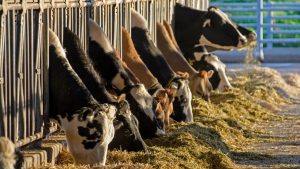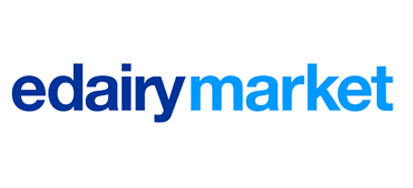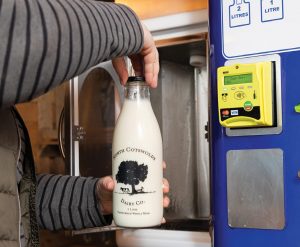
A new docuseries explores the iconic ’90s campaign.
Got irony? Back in the ’90s, “got” and “milk” were the two biggest words in the ad game. Created by Jeff Goodby—co-founder of the famed Bay Area agency Goodby, Silverstein & Partners—the dairy-hawking “Got Milk?” campaign became a pop culture phenomenon that spilled into television commercials, magazine ads, billboards, merchandise, and even must-see TV series like Friends.
But here’s the twist: “Got Milk?” inspired very few people to go out and actually get milk. Dairy sales declined even as Goodby’s campaign raked in the dough and the ad world acclaim. That disconnect between advertiser and client is one of the narratives explored in The Price of Milk, a four-part docuseries premiering at the Tribeca Festival that showcases the many and varied complexities behind America’s dairy industry.
Directed by Nicholas Bruckman and Yoni Brook, the series finds Goodby reflecting on the legacy of that simple catchphrase and the not-so-simple truths it masked about how the campaign was funded and who ultimately benefited. (Hint: It wasn’t the dairy farmers.)
“It’s probably the most parodied and copied thing we’ve ever done, and we haven’t worked on it for 15 years,” Goodby tells ADWEEK about “Got Milk’s” glory days. “It was the best shot the dairy industry could have for cow’s milk. That’s what makes the series so interesting.”
In a candid conversation, Goodby and the filmmakers discuss the real price of the udderly… uh, utterly consequential “Got Milk?” campaign.
Watch an exclusive clip from The Price of Milk below:
[This interview has been edited for length and clarity.]
ADWEEK: Nicholas and Yoni, you’re certainly of the age to have seen Jeff’s “Got Milk?” ads during their original run. When did you start wondering about the story behind the campaign?
Nicholas Bruckman: We’re both kids of the ’90s, so we grew up mesmerized by Jeff’s work, including the original Aaron Burr “Got Milk?” ad, which I’ve now seen from every single angle. I don’t think I knew back then that a young Michael Bay directed it, but it definitely had an influence on my subsequent career. What we’ve discovered through this project is that milk is a prism through which you can look at almost all aspects of American culture, and reflects a lot of the issues Yoni and I have worked on in our other films.
It was important for us not to make a series that told people not to drink milk. We wanted to celebrate the farmers and make sure that people understand that the food system is quite complex. It’s not about what you drink or don’t drink. It’s about how we relate to each other in our social and political structures, and the “Got Milk?” campaign is a fun way to get into those heavier topics.
Yoni Brook: What makes “Got Milk?” such a potent campaign is that it dripped into all of our brains almost by osmosis. We wanted to celebrate the creativity that went into reimagining what had been an American staple while at the same time recognizing that milk is not just a product to be marketed to us. It’s a product that’s really core to our national identity. There’s almost nothing more American than the image of a farmer trying to make a business work with a couple hundred cows.
Jeff Goodby: There’s great footage in the film of one couple with a dairy farm in Wisconsin [Joe and Brenda Cochran]. Those two were my clients in a way, and I feel for their unhappiness in the effects of the campaign on a national level.

To that end, the film makes the point that for all of its pop culture ubiquity and awards, the “Got Milk?” campaign didn’t move the needle in terms of sales. That’s an interesting tension to explore.
Goodby: At the time, I felt like we were doing good work, frankly. I didn’t have any doubts about the mission. I do think the mission has changed since then, and I understand that. But there are still small farmers out there who would still give that same interview today about how national advertising is not helping them. And who knows? It’s a tough business.
Bruckman: The nuance that Jeff brings to this story is not about whether the ads were good. Of course, the ads were good—we’re still talking about them 30 years later! But the mechanics under which those messages were delivered also take us up into the halls of power in this country. The farmers don’t critique the quality of the ads; they’re critiquing the underlying systems that bring people messages about their food.
Brook: We’re in a time when Americans are asking themselves what government is for and how much government we need. “Got Milk?” provides a way into those questions in a way that’s more relevant than ever. We want the government to support us, but there are other ways in which it feels like it’s not supporting the most vulnerable of us, whether it’s small farmers or school kids who don’t have a choice about which foods they eat.
“Got Milk?” launched in an entirely different era for advertising. How would you approach the campaign in the social media age?
Goodby: Well, the main question is how would you even advertise cow’s milk at this point? It’s a difficult job that involves a lot of innovative thinking around things like flavoring, packaging, and sourcing. The milk industry has not been open to a lot of innovation in that way, so I’m not sure that a big money advertising campaign—especially when its funded in part by the government—is going to be welcome or helpful.
When we started working on the original campaign in the ’90s, there was nothing more wholesome than the idea of drinking milk. But even then, people weren’t in the habit of drinking a daily glass of milk anymore. They were starting to only use milk with cereal or a latte. And then, of course, we hit the big freight train of alternative milk as people went to oat milk or almond milk to satisfy their cravings.
What are the distribution plans for The Price of Milk post-Tribeca?
Bruckman: We’re going to be sharing it with festivals across the country and are in the process of presenting it to all the major streamers and distributors. We’re also discussing showing it at small farms and in other places where people are advocating around the issues raised in the film. The last episode—which we’re not showing at Tribeca—focuses on milk in schools and it would be great to show it in that environment with young people.
Brook: There’s a huge pop culture component to the film, so we’re looking for a streaming partner that knows how to market those aspects of the project. The chance to look behind the curtain is something that I think people are excited about, and there are some streamers that are potent in that arena.
Jeff, there’s often chatter in the ad industry about whether advertisers are too focused on winning awards versus serving the client. What are your feelings on where that divide stands now?
Goodby: That’s not a recent development in advertising—people have been making ads to win awards for a long time now. In my career, the spots that hopefully make people change their minds about things are much more important to me than the spots that win awards. Those are often one-off fun things that don’t exist two weeks from now.
But “Got Milk?” still exists in people’s heads all these years later in a positive way. You still see it on the mud flaps of big trucks, and lactating mothers still wear “Got Milk?” shirts. It’s bigger than cow’s milk, and that’s what I care about. And by the way, awards are also important to me because they attract good people to work here! That’s insider baseball, sorry. [Laughs]
Given what you know about the dairy industry now, after being part of The Price of Milk, would you agree to do the campaign if it were offered to you again today?
Goodby: There are so many different levels of this stuff. In my own head, I don’t think cow’s milk is equal to promoting cigarettes or pesticide companies. I would not fault anybody for working on a cow’s milk campaign at this point, but in the wake of “Got Milk,” I’m just like, “Good luck.” How are you going to beat that?
Bruckman: From a filmmaking perspective, the messages of media literacy and knowing where the money is coming from is more central than whether or not dairy milk is a bad industry. We wanted to connect people who are actually producing milk, and yet are disconnected from these national campaigns. That’s the backdrop this is happening against, and it’s not unique to milk. It’s happening in other agricultural sectors where small farms are struggling and power flows to the big boys. Hopefully, when audiences see the series, they’ll recognize it’s bigger than milk.
You can now read the most important #news on #eDairyNews #Whatsapp channels!!!
🇺🇸 eDairy News INGLÊS: https://whatsapp.com/channel/0029VaKsjzGDTkJyIN6hcP1K























